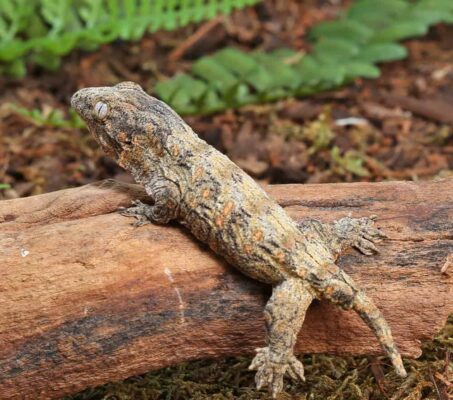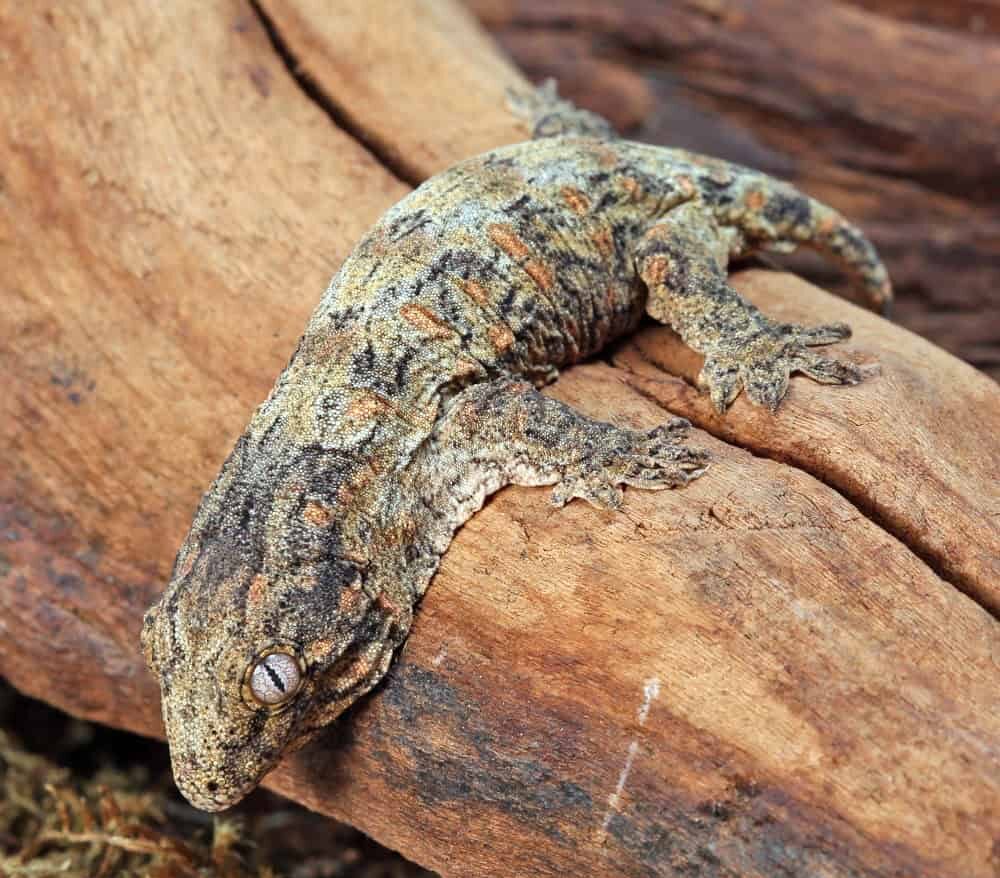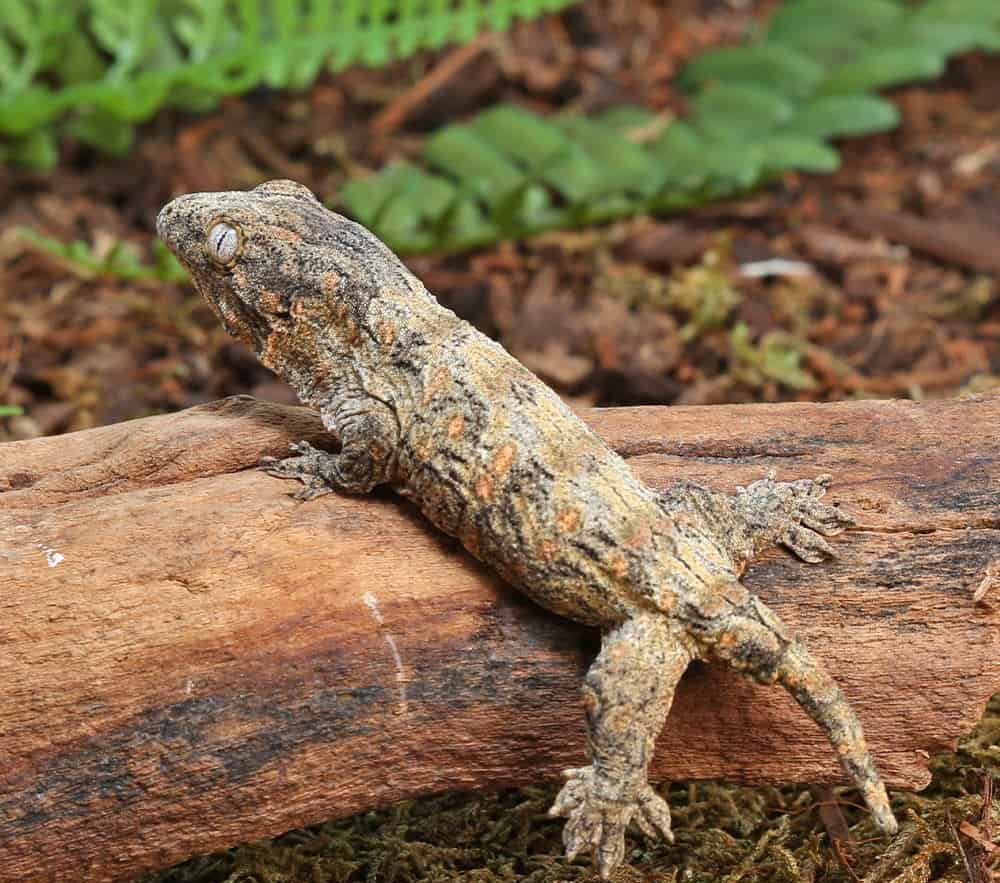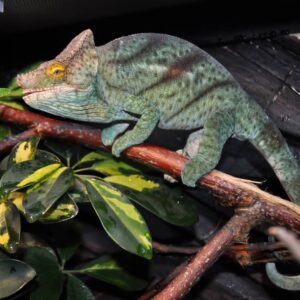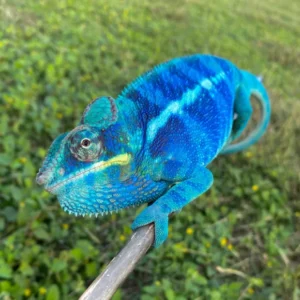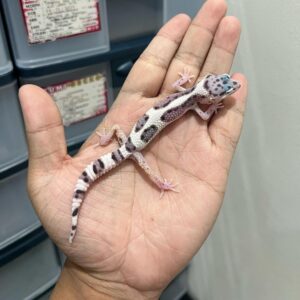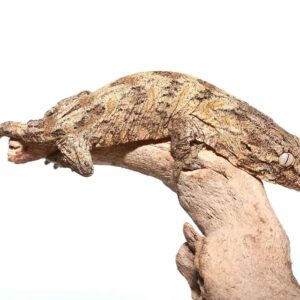High Pink Leachianus Gecko For Sale
$449.99
WE HAVE HIGH PINK LEACHIANUS GECKO FOR SALE. HERE ARE SOME HIGHLIGHTS:
- Rhacodactylus leachianus
- Captive Bred Baby
- Approximately 3 Inches From Snout To Vent
- Adults Can Grow Upwards Of 12 – 15 Inches From Head To Tail
- Feeding On Pangea Crested Gecko Diet And Crickets
Description
The High Pink Leachianus Gecko, scientifically known as Rhacodactylus leachianus, is a captivating and rare species of gecko that has garnered significant interest among reptile enthusiasts. Originating from the lush, tropical forests of New Caledonia, these geckos stand out due to their unique appearance and fascinating behavior. Unlike many other gecko species, the High Pink Leachianus exhibits a striking pink hue, which makes it a sought-after specimen in the world of exotic pets.
One of the most intriguing aspects of the High Pink Leachianus Gecko is its size. It is the largest known species of gecko, with adults often reaching lengths of up to 14 inches. This impressive size, combined with their distinctive coloration, sets them apart from other geckos and adds to their allure. Additionally, their robust build and relatively long lifespan, which can extend up to 20 years in captivity, make them a fascinating subject for long-term observation and study.
The unique characteristics of the High Pink Leachianus Gecko go beyond their physical attributes. These geckos are known for their docile temperament and adaptability, making them suitable for reptile enthusiasts of various experience levels. Their behavior in captivity is often described as calm and inquisitive, which further enhances their appeal as pets. Furthermore, their vocalizations, which include a range of clicks and growls, are distinctive and add an additional layer of interest for those who keep them.
Overall, the High Pink Leachianus Gecko is a remarkable reptile species that captivates with its rare beauty and intriguing behaviors. Whether you are a seasoned reptile keeper or a newcomer to the world of exotic pets, the High Pink Leachianus Gecko offers a fascinating glimpse into the diverse and vibrant world of geckos.
Habitat and Natural Environment
High Pink Leachianus Geckos, also known as Rhacodactylus leachianus, primarily inhabit the dense, humid rainforests of New Caledonia, an archipelago located in the southwest Pacific Ocean. These geckos are usually found in the southern and central parts of the island, where the environment provides the ideal conditions for their survival. The lush vegetation and high humidity levels of these rainforests create a perfect habitat for these fascinating reptiles.
The ecosystem of New Caledonia’s rainforests is characterized by a rich biodiversity, with a variety of plants, insects, and other small animals that form the primary diet of High Pink Leachianus Geckos. The thick canopy of trees offers ample cover and climbing opportunities, which are essential for these arboreal creatures. The geckos’ physical traits, such as their strong limbs and prehensile tails, have evolved to help them navigate this complex and vertical environment efficiently.
Temperature and humidity play a crucial role in the well-being of High Pink Leachianus Geckos. These geckos thrive in temperatures ranging from 65°F to 85°F (18°C to 29°C), with humidity levels consistently above 70%. The stable climate of their natural habitat ensures that they remain hydrated and can regulate their body temperature effectively. The microhabitats within the rainforest, including crevices in tree bark and leaf litter, provide necessary hiding spots and aid in thermoregulation.
The natural habitat of High Pink Leachianus Geckos also influences their behavior significantly. The dense forest environment necessitates a nocturnal lifestyle to avoid predators and take advantage of the cooler night temperatures. Their coloration, including the distinctive high pink hues, provides excellent camouflage against the forest backdrop, aiding in both predation and evasion.
Understanding the natural habitat and environmental conditions of High Pink Leachianus Geckos is essential for anyone looking to replicate these conditions in captivity. By mimicking their natural surroundings, enthusiasts can ensure the health and longevity of these remarkable reptiles, allowing them to exhibit natural behaviors and thrive outside their native environment.
Physical Characteristics and Coloration
The High Pink Leachianus Gecko is a remarkable specimen within the gecko family, distinguished by several notable physical characteristics. These geckos are among the largest species, typically reaching lengths of 10 to 14 inches from snout to tail tip, with some individuals growing even larger. Their robust and muscular build is complemented by a broad head and powerful limbs, which aid in their arboreal lifestyle.
The skin texture of the High Pink Leachianus Gecko is another defining trait. It is generally rough and pebbly, providing an excellent camouflage against tree bark and other natural surfaces. This texture is not just for show; it serves a functional purpose by contributing to their grip and climbing abilities. The gecko’s toes are equipped with specialized pads that allow for secure attachment to various surfaces, facilitating their movement through their habitat.
The most captivating feature of the High Pink Leachianus Gecko is undoubtedly its unique pink coloration. This pigmentation is a result of selective breeding and genetic factors that enhance the presence of red and pink hues in their skin. The intensity of the pink coloration can vary, with some geckos exhibiting a soft blush, while others display vibrant, almost fluorescent shades. This striking coloration is not merely aesthetic; it can play a role in thermoregulation and camouflage, as well as in signaling to potential mates and rivals.
When comparing the High Pink Leachianus Gecko to other morphs within the Leachianus species, the differences in coloration and patterning become evident. While some morphs may exhibit greens, browns, or grays with subtle markings, the High Pink morph stands out due to its vivid and distinctive pink tones. This makes the High Pink Leachianus Gecko a highly sought-after variant among reptile enthusiasts and breeders.
Overall, the physical characteristics and coloration of the High Pink Leachianus Gecko not only contribute to its beauty but also to its adaptability and survival within its natural habitat. The combination of size, skin texture, and unique pigmentation makes this gecko a fascinating subject for both scientific study and pet ownership.
Diet and Nutrition
High Pink Leachianus Geckos, known for their striking coloration and robust size, have specific dietary needs that must be met to ensure their health and well-being. In their natural habitat, these geckos are omnivorous, consuming a variety of insects, fruits, and small vertebrates. This diverse diet provides them with essential nutrients required for their growth and vitality.
In captivity, it is crucial to replicate this natural diet as closely as possible. A well-balanced diet for High Pink Leachianus Geckos should include a mix of live insects such as crickets, roaches, and mealworms, which are excellent sources of protein. These should be gut-loaded and dusted with calcium and vitamin D3 supplements to prevent deficiencies. Additionally, offering a variety of fruits, such as papaya, mango, and figs, can provide essential vitamins and minerals.
Feeding frequency is another important aspect to consider. Juvenile geckos require more frequent feedings, typically every one to two days, to support their rapid growth. Adult geckos, on the other hand, can be fed every three to four days. It is essential to monitor their weight and adjust feeding schedules accordingly to prevent obesity or malnutrition.
Supplementation plays a vital role in the diet of captive High Pink Leachianus Geckos. In addition to calcium and vitamin D3, a multivitamin supplement can be beneficial when provided once or twice a week. This ensures that the geckos receive all the necessary nutrients that might be missing from their diet.
Offering a variety of food items not only meets their nutritional needs but also provides mental stimulation, encouraging natural foraging behaviors. Always ensure that fresh water is readily available, and clean food and water dishes regularly to maintain hygiene. By adhering to these dietary guidelines, High Pink Leachianus Geckos can thrive in captivity, displaying their vibrant colors and robust health.
Behavior and Temperament
High Pink Leachianus Geckos, often referred to as Leachies, exhibit unique behaviors and temperaments that make them fascinating pets. These geckos are primarily nocturnal, meaning they are most active during the night. During daylight hours, they tend to be less visible, seeking refuge in secure and shaded areas within their enclosures. This nocturnal activity necessitates an enclosure that mimics their natural habitat, providing plenty of hiding spots and climbing opportunities.
Socially, High Pink Leachianus Geckos are known to have a complex array of interactions. While some individuals may tolerate cohabitation with others, it is not uncommon for territorial disputes to arise, especially among males. Therefore, it is generally recommended to house these geckos individually to prevent any aggressive encounters. Interestingly, they communicate through a series of vocalizations, including growls and barks, which are used to establish territory or express discomfort.
One of the distinctive traits of High Pink Leachianus Geckos is their relatively docile nature when compared to other gecko species. Although they can exhibit defensive behaviors if they feel threatened, they are generally more tolerant of handling. However, it is crucial to approach them calmly and confidently to avoid causing unnecessary stress. Regular, gentle handling can help in building trust between the gecko and its caretaker, but it is important to respect their boundaries and not overhandle them.
Owners should also be aware of the gecko’s unique feeding behaviors. High Pink Leachianus Geckos have a varied diet that includes both plant matter and protein sources like insects. Observing their feeding habits can provide insights into their health and well-being. Ensuring a balanced diet and proper nutrition is essential for maintaining their vibrant coloration and overall vitality.
Overall, High Pink Leachianus Geckos are intriguing pets that offer a glimpse into the complex behavioral patterns of reptiles. Their unique combination of nocturnal activity, social interactions, and relatively calm temperament makes them a captivating addition to any reptile enthusiast’s collection.
Housing and Care Requirements
Creating an ideal living environment for High Pink Leachianus Geckos is crucial for their health and well-being. The enclosure size is one of the most important factors to consider. Adult geckos require a minimum enclosure size of 18x18x24 inches, allowing them ample space to move and explore. Juveniles can be housed in smaller enclosures, but they will need to be upgraded as they grow.
Maintaining optimal temperature and humidity levels is essential for the gecko’s health. The ideal temperature range is between 75-80°F during the day and can drop to around 70°F at night. It’s important to provide a thermal gradient within the enclosure, allowing the gecko to thermoregulate. Humidity levels should be kept between 60-80%, achievable through regular misting and the use of a hygrometer to monitor levels accurately.
Necessary equipment for the enclosure includes a reliable thermostat to regulate temperature, a hygrometer for humidity checks, and appropriate lighting. While High Pink Leachianus Geckos do not require UVB lighting, providing a low-level UVB light can be beneficial. Ensure that the enclosure has a secure lid to prevent escapes, as these geckos are adept climbers.
Habitat enrichment plays a significant role in the gecko’s mental and physical health. The enclosure should include a variety of climbing structures, such as branches and vines, as well as hiding spots created with cork bark or commercial hides. Live or artificial plants can be added to mimic their natural habitat and provide additional hiding places. The substrate can be a mix of soil and coconut fiber, which helps maintain humidity and allows for natural digging behavior.
Regular cleaning of the enclosure is necessary to prevent the buildup of waste and bacteria. Spot clean daily and perform a thorough cleaning at least once a month. By adhering to these housing and care requirements, potential owners can ensure their High Pink Leachianus Geckos thrive in captivity.
Health and Common Issues
High Pink Leachianus Geckos, known for their striking coloration and unique appearance, require attentive care to maintain their health and well-being. One of the primary health concerns for these geckos is metabolic bone disease (MBD), which results from calcium deficiency. Signs of MBD can include lethargy, swollen limbs, and difficulty in movement. Preventative measures include ensuring a balanced diet rich in calcium and providing adequate UVB lighting to facilitate calcium absorption.
Another common issue is respiratory infections, often caused by improper humidity levels and poor ventilation. Symptoms to watch for include wheezing, nasal discharge, and open-mouth breathing. Maintaining appropriate humidity levels, typically between 60-80%, and ensuring proper ventilation within the habitat can significantly reduce the risk of respiratory problems. If symptoms persist, it is crucial to seek veterinary care promptly.
Parasites, both internal and external, can also pose health risks. Regular fecal examinations by a veterinarian can help detect internal parasites early. External parasites, such as mites, may be visible on the skin and can cause irritation and stress. Quarantining new geckos and maintaining a clean habitat are effective preventative strategies. If an infestation occurs, seek veterinary advice for appropriate treatment options.
Basic first aid knowledge is invaluable for addressing minor injuries. For small cuts or abrasions, cleaning the wound with a saline solution and applying a reptile-safe antiseptic can prevent infections. However, for more severe injuries or if there is no improvement, professional veterinary care is necessary.
Overall health maintenance for High Pink Leachianus Geckos involves a combination of proper diet, habitat conditions, and regular veterinary check-ups. A diet of gut-loaded insects, occasional fruit, and commercially available gecko diets provides nutritional balance. Regularly monitoring the gecko’s weight, activity levels, and physical appearance can help detect potential health issues early. By following these guidelines, owners can ensure their High Pink Leachianus Geckos thrive in captivity.
Breeding and Reproduction
Breeding High Pink Leachianus Geckos is a meticulous process that requires careful attention to detail and a deep understanding of their natural behaviors. The breeding season for these geckos typically spans from late winter to early summer, a period during which the geckos are most receptive to mating. During this time, it is essential to monitor the environmental conditions closely, ensuring that temperature and humidity levels are optimal for breeding.
High Pink Leachianus Geckos exhibit unique mating behaviors that include vocalizations and physical displays. Males often emit a series of calls to attract females, and these vocalizations can be a key indicator that the geckos are ready to mate. Observing these behaviors can help breeders identify the right time to introduce potential mates. When introducing pairs, it is crucial to do so gradually to minimize stress and aggression, which can negatively impact the breeding process.
Once mating has occurred, the female gecko will typically lay eggs within four to six weeks. She will seek out a secure, humid location to deposit her eggs, so providing a suitable nesting site with appropriate substrate is vital. After the eggs are laid, they should be carefully collected and placed in an incubation container with a consistent temperature range of 75-80°F and humidity levels around 80%. Proper incubation conditions are critical to ensure the development and hatching of healthy geckos.
Caring for hatchlings requires a separate set of considerations. Young High Pink Leachianus Geckos are delicate and require a controlled environment with stable temperatures and humidity. Feeding them a diet of appropriately sized insects and commercially available gecko food can support their growth and development. Monitoring their health and behavior closely during these early stages can help identify any potential issues early on and ensure the young geckos thrive.
For both hobbyists and professional breeders, understanding the intricacies of breeding and reproduction in High Pink Leachianus Geckos is essential for success. By providing the right environment, observing mating behaviors, and ensuring proper care for eggs and hatchlings, breeders can contribute to the thriving population of these fascinating reptiles.
